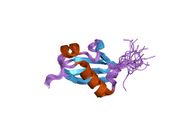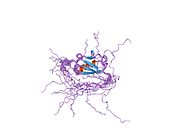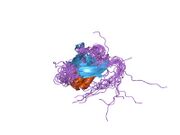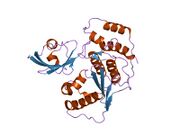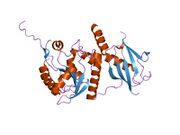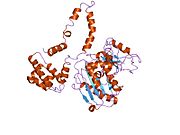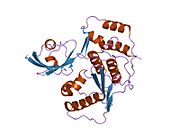Biology:SUMO2
Small ubiquitin-related modifier 2 is a protein that in humans is encoded by the SUMO2 gene.[1]
Function
This gene encodes a protein that is a member of the SUMO (small ubiquitin-like modifier) protein family. It is a ubiquitin-like protein and functions in a manner similar to ubiquitin in that it is bound to target proteins as part of a post-translational modification system. However, unlike ubiquitin, which is primarily associated with targeting proteins for proteasomal degradation, SUMO2 is involved in a variety of cellular processes, such as nuclear transport, transcriptional regulation, apoptosis, and protein stability. It is not active until the last two amino acids of the carboxy-terminus have been cleaved off. Numerous pseudogenes have been reported for this gene. Alternate transcriptional splice variants encoding different isoforms have been characterized.[2]
Interactions
SUMO2 has been shown to interact with TRIM63[3] and CFAP298.[4]
Clinical significance
Deep hypothermia protects the brain from ischemic injury, which is why it's employed for major cardiovascular procedures that necessitate cardiopulmonary bypass and a period of circulatory arrest. With an experiment [5]conducted to moderate hypothermia, small ubiquitin-like modifier (SUMO1-3) conjugation was significantly activated in the brain. The effects of hypothermia on SUMO conjugation were evaluated in this experiment[5] using Western blot and immunohistochemistry in animals that were either normothermic (37°C) or deep to moderate (18°C, 24°C, 30°C) hypothermic cardiopulmonary bypass. In these cells, even 30°C hypothermia was enough to significantly boost SUMO2/3-conjugated protein levels and nucleus accumulation. Deep hypothermia caused the SUMO-conjugating enzyme Ubc9 to translocate to the nucleus, implying that the increase in nuclear levels of SUMO2/3-conjugated proteins seen in hypothermic animals' brains is an active process. Deep hypothermia caused only a small increase in the amounts of SUMO2/3-conjugated proteins in primary neuronal cells. This shows that neurons in vivo have a greater capacity to activate this endogenous possibly neuroprotective mechanism when exposed to hypothermia than neurons in vitro. Identifying proteins that are SUMO2/3 conjugated during hypothermia could aid in the development of new preventive and therapeutic therapies to make neurons more resistant to a transient blood supply interruption.
References
- ↑ "Cloning and expression of human homolog HSMT3 to yeast SMT3 suppressor of MIF2 mutations in a centromere protein gene". Biochemical and Biophysical Research Communications 222 (1): 178–80. May 1996. doi:10.1006/bbrc.1996.0717. PMID 8630065. https://zenodo.org/record/1229472.
- ↑ "Entrez Gene: SUMO2 SMT3 suppressor of mif two 3 homolog 2 (S. cerevisiae)". https://www.ncbi.nlm.nih.gov/sites/entrez?Db=gene&Cmd=ShowDetailView&TermToSearch=6613.
- ↑ "A novel human striated muscle RING zinc finger protein, SMRZ, interacts with SMT3b via its RING domain". The Journal of Biological Chemistry 276 (26): 23992–9. Jun 2001. doi:10.1074/jbc.M011208200. PMID 11283016.
- ↑ "System-wide changes to SUMO modifications in response to heat shock". Science Signaling 2 (72): ra24. 2009. doi:10.1126/scisignal.2000282. PMID 19471022.
- ↑ Jump up to: 5.0 5.1 Wang, Liangli; Ma, Qing; Yang, Wei; Mackensen, G. Burkhard; Paschen, Wulf (November 2012). "Moderate hypothermia induces marked increase in levels and nuclear accumulation of SUMO2/3-conjugated proteins in neurons" (in en). Journal of Neurochemistry 123 (3): 349–359. doi:10.1111/j.1471-4159.2012.07916.x. PMID 22891650.
Further reading
- "Oligo-capping: a simple method to replace the cap structure of eukaryotic mRNAs with oligoribonucleotides". Gene 138 (1–2): 171–4. Jan 1994. doi:10.1016/0378-1119(94)90802-8. PMID 8125298.
- "SMT3A, a human homologue of the S. cerevisiae SMT3 gene, maps to chromosome 21qter and defines a novel gene family". Genomics 40 (2): 362–6. Mar 1997. doi:10.1006/geno.1996.4556. PMID 9119407.
- "Construction and characterization of a full length-enriched and a 5'-end-enriched cDNA library". Gene 200 (1–2): 149–56. Oct 1997. doi:10.1016/S0378-1119(97)00411-3. PMID 9373149.
- "Covalent modification of PML by the sentrin family of ubiquitin-like proteins". The Journal of Biological Chemistry 273 (6): 3117–20. Feb 1998. doi:10.1074/jbc.273.6.3117. PMID 9452416.
- "Characterization of a second member of the sentrin family of ubiquitin-like proteins". The Journal of Biological Chemistry 273 (18): 11349–53. May 1998. doi:10.1074/jbc.273.18.11349. PMID 9556629.
- "Functional heterogeneity of small ubiquitin-related protein modifiers SUMO-1 versus SUMO-2/3". The Journal of Biological Chemistry 275 (9): 6252–8. Mar 2000. doi:10.1074/jbc.275.9.6252. PMID 10692421.
- "A novel mammalian Smt3-specific isopeptidase 1 (SMT3IP1) localized in the nucleolus at interphase". European Journal of Biochemistry 267 (21): 6423–7. Nov 2000. doi:10.1046/j.1432-1327.2000.01729.x. PMID 11029585.
- "A novel human striated muscle RING zinc finger protein, SMRZ, interacts with SMT3b via its RING domain". The Journal of Biological Chemistry 276 (26): 23992–9. Jun 2001. doi:10.1074/jbc.M011208200. PMID 11283016.
- "Polymeric chains of SUMO-2 and SUMO-3 are conjugated to protein substrates by SAE1/SAE2 and Ubc9". The Journal of Biological Chemistry 276 (38): 35368–74. Sep 2001. doi:10.1074/jbc.M104214200. PMID 11451954.
- "Characterization of a novel mammalian SUMO-1/Smt3-specific isopeptidase, a homologue of rat axam, which is an axin-binding protein promoting beta-catenin degradation". The Journal of Biological Chemistry 276 (42): 39060–6. Oct 2001. doi:10.1074/jbc.M103955200. PMID 11489887.
- "Modification of the human thymine-DNA glycosylase by ubiquitin-like proteins facilitates enzymatic turnover". The EMBO Journal 21 (6): 1456–64. Mar 2002. doi:10.1093/emboj/21.6.1456. PMID 11889051.
- "Transcriptional activity of CCAAT/enhancer-binding proteins is controlled by a conserved inhibitory domain that is a target for sumoylation". The Journal of Biological Chemistry 277 (41): 38037–44. Oct 2002. doi:10.1074/jbc.M207235200. PMID 12161447.
- "Molecular features of human ubiquitin-like SUMO genes and their encoded proteins". Gene 296 (1–2): 65–73. Aug 2002. doi:10.1016/S0378-1119(02)00843-0. PMID 12383504.
- "The histone deacetylase 9 gene encodes multiple protein isoforms". The Journal of Biological Chemistry 278 (18): 16059–72. May 2003. doi:10.1074/jbc.M212935200. PMID 12590135.
- "Phosphorylation of serine 303 is a prerequisite for the stress-inducible SUMO modification of heat shock factor 1". Molecular and Cellular Biology 23 (8): 2953–68. Apr 2003. doi:10.1128/MCB.23.8.2953-2968.2003. PMID 12665592.
- "Modification of CCAAT/enhancer-binding protein-beta by the small ubiquitin-like modifier (SUMO) family members, SUMO-2 and SUMO-3". The Journal of Biological Chemistry 278 (35): 33416–21. Aug 2003. doi:10.1074/jbc.M305680200. PMID 12810706.
- "Role of an N-terminal site of Ubc9 in SUMO-1, -2, and -3 binding and conjugation". Biochemistry 42 (33): 9959–69. Aug 2003. doi:10.1021/bi0345283. PMID 12924945.
- "In vitro modification of human centromere protein CENP-C fragments by small ubiquitin-like modifier (SUMO) protein: definitive identification of the modification sites by tandem mass spectrometry analysis of the isopeptides". The Journal of Biological Chemistry 279 (38): 39653–62. Sep 2004. doi:10.1074/jbc.M405637200. PMID 15272016.

